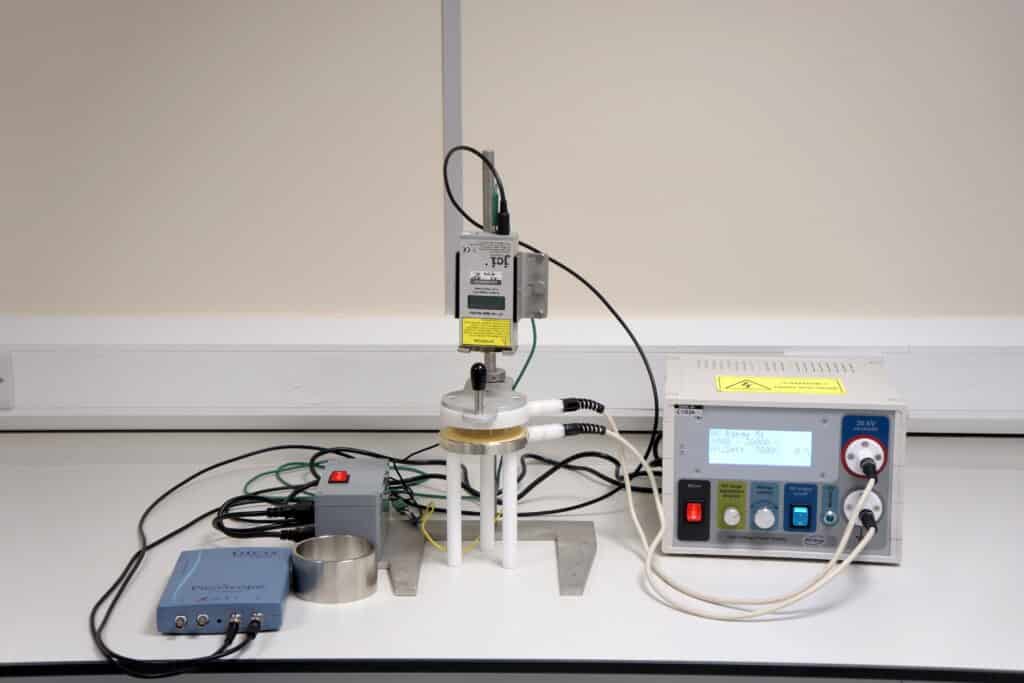
Our Solutions: Testing
Our laboratories generate test data on electrostatic hazards and electrostatic potential.
Electrostatic testing
Electrostatic discharge can be a constantly hazardous threat to your business, workplace and people. With the potential risk for both fire and explosions, electrostatic discharge can add complications to your operations. Sigma-HSE’s electrostatic testing lab offers comprehensive standard and custom testing packages to aid you in identifying and reducing electrostatic hazards and other associated risks.
We offer a wide range of electrostatic and ESD testing services to ISO/IEC 17025:2017 standards, globally.
Discover our range of tests below and get in touch for a free consultation today.
BS EN ISO IEC 80079-20-2 / BS EN 60079-32-2: 2015 / PD CLC TR 60079-32-1
The powder volume resistivity test is performed to establish the materials electrical conductivity, either conductive, static dissipative or insulating.
The test is conducted by passing predetermined voltage between two electrodes of known geometric size through the powder, under the specific test conditions. Generally direct resistance is measured, and the resistivity calculated using the following equation:
Many materials absorb atmospheric moisture or attract it to its particles surface. Addition or removal of this moisture often has a marked effect on the materials resistivity. Therefore, preconditioning and testing is performed under controlled relative humidity conditions of 25 (± 5) % and 23 (± 2) °C.
The test classifies a material using the following standardized boundaries:
As per BS EN ISO / IEC 80079-20-2: 2016 Explosive atmospheres Part 20-2: Material characteristics – Combustible dusts test methods, powders may be grouped according to their resistivity as follows:
As per PD CLC TR 60079-32-1:2018 – Explosive atmospheres. Electrostatic hazards guidance, powders may be grouped according to their resistivity as follows:
In practical terms, during handling of bulk materials electrostatic charging normally occurs. The volume resistivity of a powder dictates how efficiently charge migrate through a material by electrical conduction. The higher the volume resistivity value, the more resistive the powder is. High resistivity powders will accumulate and retain charge presented to it in all situations. Low and most mid-range resistivity materials (conductive and static dissipative) will dissipate charge, providing it has a good path to earth.
This can be achieved by handling these powders in a well earthed environment (earthed conductive or static dissipative containers, silos, hoppers, and plant equipment). The build-up and retention of charge on a powder or equipment possess the biggest threat if the charge is suddenly released in the form of a spark discharge, which can cause an ignition of a flammable atmosphere. Therefore it is imperative to know and understand the electrostatic properties of your powders to ensure they are handled correctly to prevent discharges and potential ignition of flammable atmospheres.
BS EN 60079-32-2
The test is conducted to establish whether a liquid will allow an electrical charge to migrate through it or not and therefore its ability to accumulate and retain a charge.
The liquid to be tested is slowly charged into a cylindrical, measuring test cell comprising of an inner pole and a concentric outer electrode. A voltage is applied, and the current is measured from one electrode to the other. Using the current value measured, a liquid conductivity is calculated using the test cells constant, determined from its geometry.
The test classifies a material using the following standardized boundaries:
As per PD IEC/TS 60079-32-1:2018 – Explosive atmospheres. Electrostatic hazards guidance, liquids may be classified according to their conductivity as follows:
The level of charge accumulation in a particular liquid, and therefore the electrostatic hazard
that can be created, is strongly dependent upon its electrical conductivity and dielectric
constant (relative permittivity), εr. To describe the possible hazards and associated means of prevention, the conductivities of liquids have been classified as follows:
For liquids with a dielectric constant of around 2, (e.g. hydrocarbons), these classifications reduce to:
The upper border limit of medium conductivity remains at 10 000 pS/m.
The test allows for correct handling procedures to be established. A material with a low conductivity would be considered insulating and therefore stop migration of charge. With a charging mechanism present, accumulation of potentially hazardous levels of charge may occur.
A material with a high conductivity would be considered static dissipative or conductive and freely allow charge to migrate, therefore, providing it is adequately connected to earth, charge accumulation will not likely occur. Charged material can in turn, through induction charging, charge local isolated conductors, which could present an ignition risk if located within a flammable atmosphere. i.e. electrically isolated personnel working in a potentially flammable atmosphere where the insulating liquid is either being handled or stored.
Conductive materials should equally be treated with caution and always be earthed. Discharges from the surface of a charged, isolated conductive liquid can easily cause ignition of head space vapors.
BS EN 61340-2-3 / BS EN 1149-1
Surface resistivity is a calculated value based upon the measured surface resistance using a test cell with known geometry. It is an inherent property of the surface of a material and is independent of sample size. Testing is conducted by applying a range of voltages from one electrode in intimate contact with the specimen’s surface and measuring either a current or direct resistance across the surface to a second electrode. The values of either measured or calculated resistance are multiplied by a cell constant, generated from the test cells geometric sizes and configuration to derive a Surface Resistivity value. The unit of surface resistivity is the ohm, however, to differentiate between surface resistance (dependent on sample size) and surface resistivity, often the value is displayed in Ohms per Square (Ω/□).
Surface resistivity indicates the ability to a material to allow charge to migrate across its surface. A material with a high surface resistivity would be considered to be insulating and therefore stop migration of charge. With a charging mechanism present, accumulation of potentially hazardous levels of charge may occur. A material with a low surface resistivity would be considered to be static dissipative or conductive and freely allow charge to migrate, therefore, providing it is adequately connected to earth, charge accumulation will not likely occur.
The test is predominantly conducted on liners, hoses, sheet materials and laminates (BS EN 61340-2-3 “Methods of test for determining the resistance and resistivity of solid planar materials to avoid electrostatic charge accumulation”) or items of clothing / personal protective equipment (PPE) (EN 1149-1 “Protective clothing – Electrostatic properties – Part 1: Test method for measurement of surface resistivity”)
The test classifies a material using the following standardized boundaries:
The following definitions are given as guidance by PD CLC TR 60079-32-1 “Explosive atmospheres – Part 32-1: Electrostatic hazards, guidance”.
Definition | Surface Resistivity (Ω or Ω/o) |
Conductive | < 105 |
Dissipative | 105 to < 1012 |
Insulating | > 1012 |
BS EN 61340-2-3 / BS EN 1149-2
Volume resistivity is a calculated value based upon the measured volume resistance using a test cell with known geometry. It is an inherent property of a material and is independent of sample size. Testing is conducted by applying a range of voltages from one electrode in intimate contact with the specimen’s surface and measuring either a current or direct resistance across the surface to a second electrode. The values of either measured or calculated resistance are equated with a cell constant, generated from the test cells geometric sizes and configuration and the tested materials thickness, to derive a volume resistivity value. The unit of volume resistivity is Ohm meters (Ωm).
Volume resistivity indicates the ability to a material to allow charge to migrate through its bulk. A material with a high volume resistivity would be considered to be insulating and therefore stop migration of charge. With a charging mechanism present, accumulation of potentially hazardous levels of charge may occur. A material with a low volume resistivity would be considered to be static dissipative or conductive and freely allow charge to migrate, therefore, providing it is adequately connected to earth, charge accumulation will not likely occur.
The test is predominantly conducted on liners, hoses, sheet materials and laminates (BS EN 61340-2-3 “Methods of test for determining the resistance and resistivity of solid planar materials to avoid electrostatic charge accumulation”) or items of clothing / personal protective equipment (PPE) (EN 1149-1 “Protective clothing – Electrostatic properties – Part 2: Test method for measurement of the electrical resistance through a material (vertical resistance)”).
The test classifies a material using the following standardized boundaries:
The following definitions are given as guidance by IEC 60079-32-1 “Explosive atmospheres – Part 32-1: Electrostatic hazards, guidance”.
| Definition | Volume resistivity (Wm) |
| Conducting | < 104 |
| Dissipative | 104 – 109 |
| Insulating | > 109 |
BS 7506 & BS 5958
The powder charge relaxation time test is performed to establish the materials ability to dissipate electrostatic charge when exposed to high electrical potential (voltage).
The material to be tested is placed into an earthed stainless steel sample cup and using corona charging the sample is sprayed with a potential of approximately 10 kV. The charging plate is retracted, revealing the charged material to the field meter and the acquisition system is automatically initiated. The sample voltage is monitored and recorded by the electrostatic field meter, and voltage versus time is graphically displayed using the acquisition software connected to the field meter output.
Charge relaxation time or charge decay constant is a very good indication of a material’s ability to self-dissipate static charge. A dissipative material will allow charge to migrate over its surface and/or through its volume in a time that is short compared to an insulating material, which will exhibit a long undesirable charge relaxation time.
From powder volume resistivity to liquid conductivity, Sigma-HSE is your single solution provider for a range of electrostatic testing. Our dedicated team of experts are committed to helping you ensure and maintain compliance.
Receive quick and accurate data in just a few simple steps
Get in touch with one of our experts so we can learn more about your specific requirements. We’ll then generate and send you a customized quote.
Prepare your samples and ship them to one of our global laboratories.
Once we’ve received your samples, we’ll begin testing and analyzing. We’ll then create and send you a custom in-depth report with actionable insights.
If you need support after receiving your report, our after-sales support team will be on hand to assist you with any questions you may have.
Testing for the electrostatic potential of your facilities materials is an important
aspect of safety compliance. Learn more about how we can assist you today.

Are you visiting Sigma-HSE from outside your region? Visit your regional site for more relevant process safety solutions.